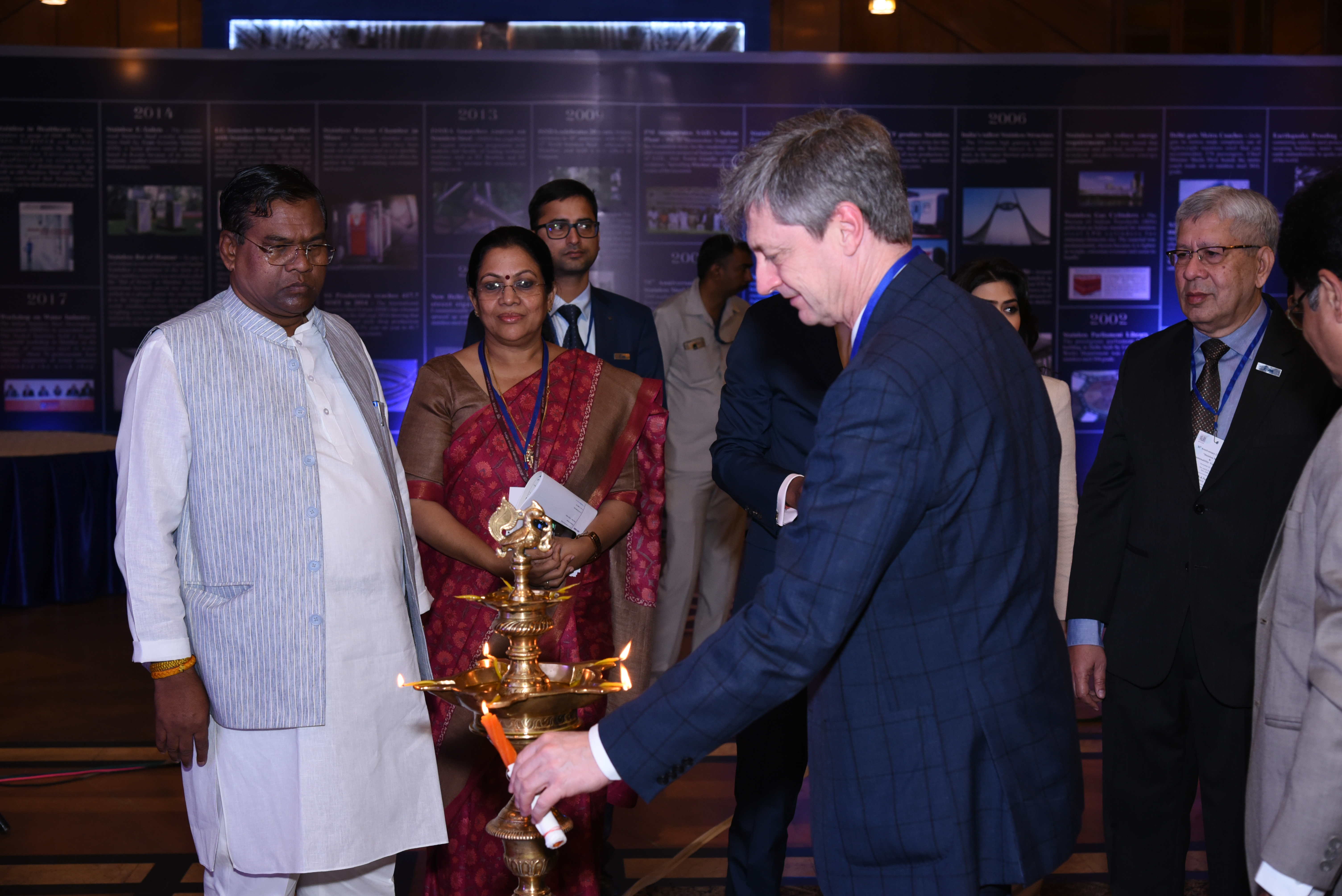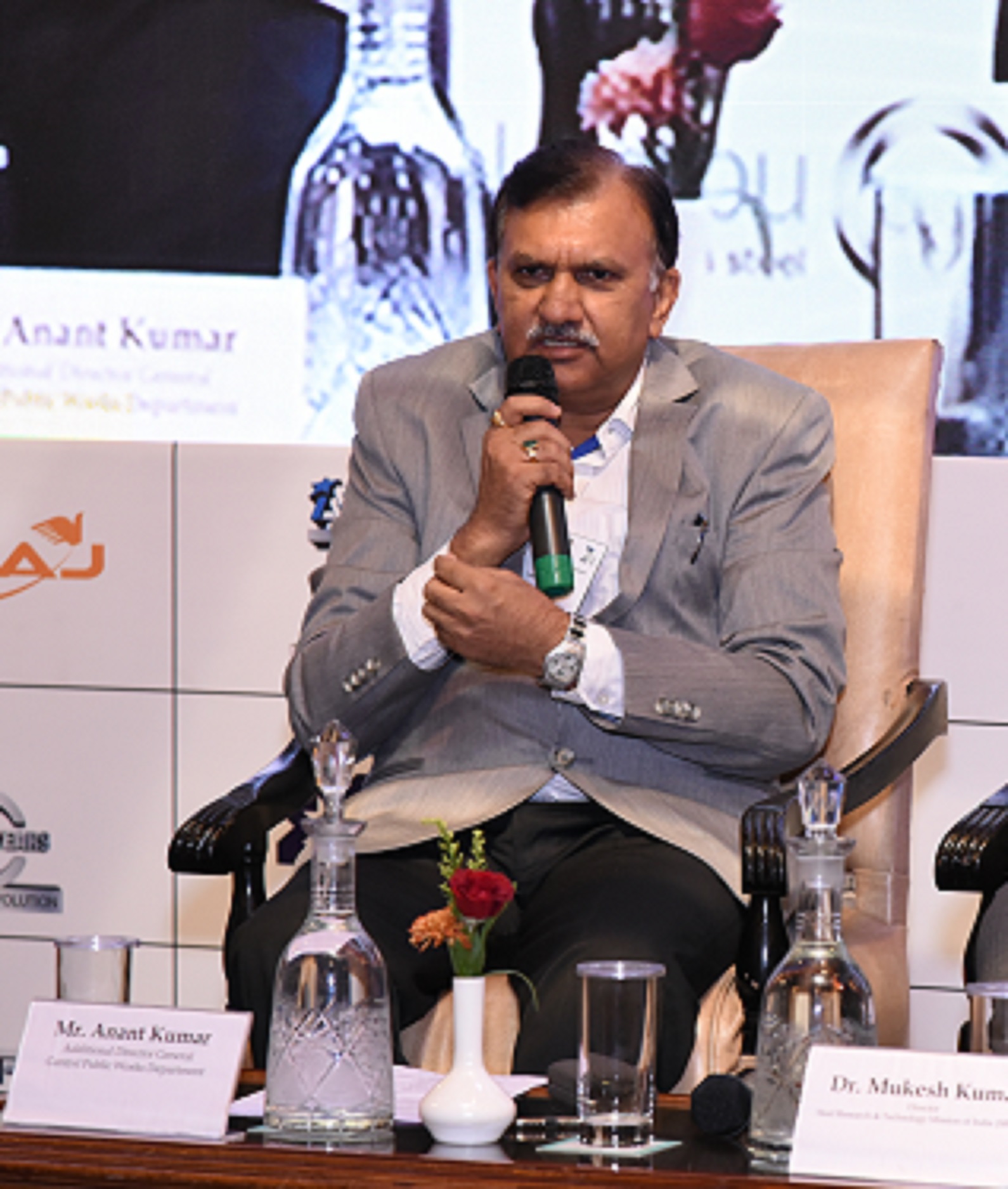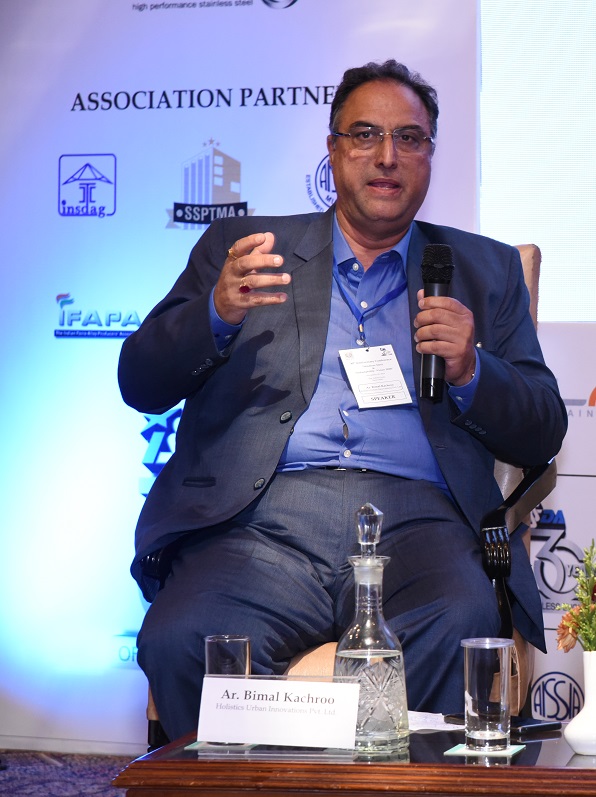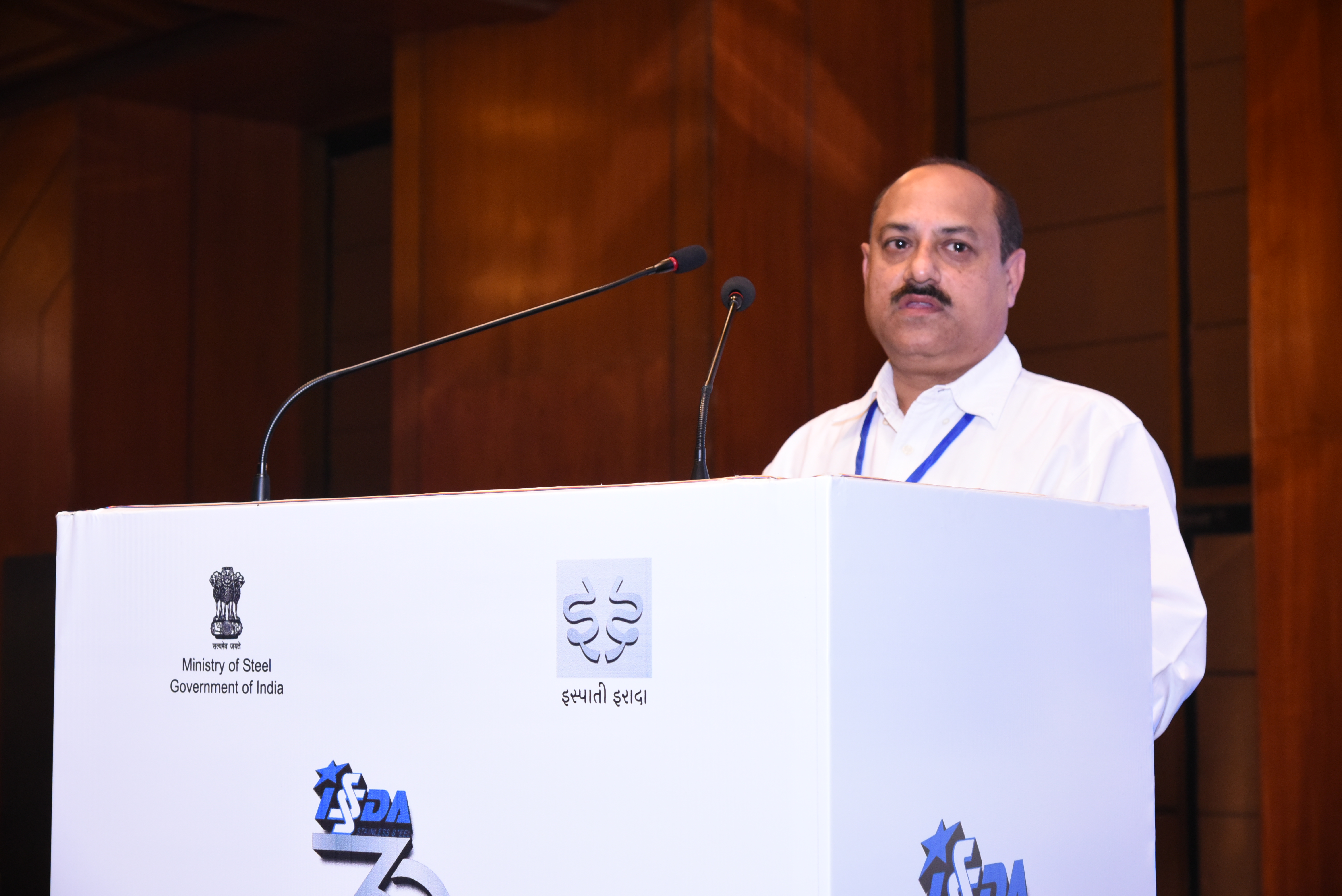ISSDA 30th Year Celebration and Conference

Download Photographs
ISSDA 30th anniversary conference: ‘Stainless Steel and sustainability – Vision 2030’
New Delhi, 18th November 2019
.JPG)

Record of proceedings:
Mr. KK Pahuja, President ISSDA, welcomed the guests.
Stainless Steel per capita consumption in India has increased from 1.2 Kg in 2010 to 2.5 Kg in 2019. This is due to untiring efforts by ISSDA along with its members with Government support, in fact per capita stainless-steel consumption has increased by 25% in last 3 years. ISSDA thanked Ministry of steel and the members for continued support to the cause of Stainless-Steel. ‘Ispati Irada’, the inspirational statement from Ministry of Steel, was adopted at the conference with the pledge to accelerate the growth of stainless-steel industry.
 Mr. Rattan Jindal, Chairman, Jindal Stainless Limited, in his opening address praised various initiatives taken by Ministry of Steel in helping the Steel Industry in general and Stainless Steel in particular. He lauded the campaign of “Ispati Irada” by the Ministry. He noted that the Ministry is trying to make India as a hub of value-added steel. In this context, he said that Stainless Steel is at the highest spectrum of Value-Added Steel. The transport sector is utilising the higher crash and fire resistance property of Stainless Steel, Architects are using the corrosion and accident resistance property of Stainless steel while Food and Medical industry is exploiting the inherent hygienic property of Stainless Steel. In India, 40% of Stainless Steel is being produced by MSME Sector and 50% of total SS consumption is going in utensil sector.
Mr. Rattan Jindal, Chairman, Jindal Stainless Limited, in his opening address praised various initiatives taken by Ministry of Steel in helping the Steel Industry in general and Stainless Steel in particular. He lauded the campaign of “Ispati Irada” by the Ministry. He noted that the Ministry is trying to make India as a hub of value-added steel. In this context, he said that Stainless Steel is at the highest spectrum of Value-Added Steel. The transport sector is utilising the higher crash and fire resistance property of Stainless Steel, Architects are using the corrosion and accident resistance property of Stainless steel while Food and Medical industry is exploiting the inherent hygienic property of Stainless Steel. In India, 40% of Stainless Steel is being produced by MSME Sector and 50% of total SS consumption is going in utensil sector.
Mr. Jindal requested for the support of Ministry of Steel in creating a level playing field for Indian SS Industry to compete with foreign players as irresponsible surplus capacities in the neighbouring countries has played havoc world over. While not becoming a part of RCEP is a welcome move, review of existing FTAs, withdrawal of LDR and review of non-refundable taxes is also requested.
 Chief Guest, Mr. Faggan Singh Kulaste ji, Honourable, Minister of State, Ministry of Steel, in his Inaugural address, congratulated ISSDA and the Stainless-Steel Industry in achieving the 2nd position in the world in production and consumption of Stainless Steel. While the world average growth of Stainless Steel is 5%, in India Stainless Steel consumption is growing at around 8% rate. He highlighted the decision of Ministry of Railways to go for 100% coaches made of Stainless Steel. This not only will help Railways in lower life cycle costing but will help the passengers also in form of safety and comfort. Railways’ decision of going for SS bio-toilets will help in saving the environment. Smart cities will also need more Stainless Steel. He once again highlighted the advantage Stainless Steel gives in the form of lower Life Cycle Costing.
Chief Guest, Mr. Faggan Singh Kulaste ji, Honourable, Minister of State, Ministry of Steel, in his Inaugural address, congratulated ISSDA and the Stainless-Steel Industry in achieving the 2nd position in the world in production and consumption of Stainless Steel. While the world average growth of Stainless Steel is 5%, in India Stainless Steel consumption is growing at around 8% rate. He highlighted the decision of Ministry of Railways to go for 100% coaches made of Stainless Steel. This not only will help Railways in lower life cycle costing but will help the passengers also in form of safety and comfort. Railways’ decision of going for SS bio-toilets will help in saving the environment. Smart cities will also need more Stainless Steel. He once again highlighted the advantage Stainless Steel gives in the form of lower Life Cycle Costing.
He urged the participants to come out with a roadmap for increasing the use of Stainless Steel in the country to at least world average of 6 Kg per capita from the current level of 2.5 Kg per capita.
 Additional Secretary, Ministry of Steel, Smt. Rasika Chaube, delivered address on policy perspective. She called upon the participants of the seminar to enhance awareness about sustainability of Stainless Steel.
Additional Secretary, Ministry of Steel, Smt. Rasika Chaube, delivered address on policy perspective. She called upon the participants of the seminar to enhance awareness about sustainability of Stainless Steel.
Sustainability means the material shall be Planet friendly, People friendly and Pocket friendly. Planet friendly means, it should be having long life, low maintenance and should be reusable, recyclable. People friendly means material should be easy to use, easy to produce. Pocket friendly means the life cycle cost should be low. Stainless Steel fulfils all these criteria.
She said that Stainless Steel has high potential mainly in three areas Urban Infrastructure, Urban Transport and Processing Industry. In Urban Infrastructure making use of corrosion resistance property of SS, it can be used in water pipelines, desalination plants, sewage treatment plants, storage & transport of water.
For urban transport, utilising the higher strength/weight ratio, SS can be used in Bus Body, wagons, coaches, bio toilets, exhaust to meet euro 6 norms etc. Food processing Industry can exploit the hygienic aspect of stainless steel.
Policy on Domestically Manufactured Iron & Steel Products (DMISP) can also be exploited by the domestic producers for faster growth.
She informed that the Ministry is working with Jal Shakti Ministry for increasing use of Stainless Steel in the water Industry. Ministry has also written to CPWD to increase use of SS water tanks. Ministry is also working with Rail Ministry where SS is already being used in wagons and coaches. Now MECON has been asked to design Railway Stations using maximum possible Stainless Steel. NHAI has also been asked to plan more and more bridges using stainless Steel.
Out of 66 Quality Control Orders issued by the Ministry, 6 are for Stainless Steel which covers nearly 65% of Stainless-Steel products. This not only helps improving the quality of products but also serves as non-tariff barrier to imports.
Ministry has taken up with the department of revenue for changing the duty structure to provide level playing field for domestic producers.
GFR rule 136 has been made highlighting the concept of LCC in procurement. Now the Ministry is proposing to make amendment to use LCC concept as a compulsory part of taking procurement decisions in government departments and PSUs.
Ministry has increased the R & D budget from Rs.15 Cr to Rs.100 Cr.
 Mrs. Pooja Mehra, Executive Director, Viraj Profiles Ltd, in her address, congratulated ISSDA on completing 30 years serving the industry and felt that several major milestones were achieved during this period. She wished that ISSDA continue to work on development challenges for Stainless Steel in the country.
Mrs. Pooja Mehra, Executive Director, Viraj Profiles Ltd, in her address, congratulated ISSDA on completing 30 years serving the industry and felt that several major milestones were achieved during this period. She wished that ISSDA continue to work on development challenges for Stainless Steel in the country.

In the Industry address, Dr. S. K. Jha, Director (Production & Marketing), MIDHANI discussed various applications of Stainless Steel in strategic sectors like defence, nuclear power and space. There is tremendous scope of various special grades in these sectors. By fine tuning of the properties, SS can even substitute Maraging steel. MIDHANI is also developing weld consumables along with the new modified grades of Stainless steel so that these grades can be fabricated with ease.
 Mr. Richard Matheson, Director, Nickel Institute, while delivering the Theme Address, highlighted the opportunities and threats Stainless Steel is facing. The major threats, which we as the Stainless Steel Industry has to overcome are 1) Substitution / Competition from other material, 2) High initial cost, 3) Barriers to entry like difficulties in supply chain, lack of standards and approvals, 4) Lack of knowledge in the domain where it can be actually used and 5) health and reputation issues by adverse media.
Mr. Richard Matheson, Director, Nickel Institute, while delivering the Theme Address, highlighted the opportunities and threats Stainless Steel is facing. The major threats, which we as the Stainless Steel Industry has to overcome are 1) Substitution / Competition from other material, 2) High initial cost, 3) Barriers to entry like difficulties in supply chain, lack of standards and approvals, 4) Lack of knowledge in the domain where it can be actually used and 5) health and reputation issues by adverse media.
Key areas where high tonnage can be consumed currently are water distribution, structures and bridges, marine corrosion and reinforcement bars in critical areas. In these areas Stainless steel is a natural option and currently we are in high opportunity environment of Industrial Revolution 5.0
In USA, structural codes for Stainless Steel are ready which can be used anywhere to promote use of Stainless Steel.
 Mr. Markus A. Moll, Managing Director, SMR GbbH, Austria delivered keynote address. He presented the past statistics of country wise stainless-steel production and consumption, world over. Also presented was sector wise consumption of SS and their prospects in future. In the world scenario, consumer goods consume 49% of total SS and this sector is stagnant. Chemical, Petrochemical and Energy sector consumes 15% and is also stagnant. Automotive and Heavy Transport sector consumes 12% of total SS and is current facing downward trend. Industrial sector and other are 8% and does not have positive outlook. Only sector with positive outlook world over is ABC (Architecture, building and Construction) & Infra which is currently consuming 16% of total SS.
Mr. Markus A. Moll, Managing Director, SMR GbbH, Austria delivered keynote address. He presented the past statistics of country wise stainless-steel production and consumption, world over. Also presented was sector wise consumption of SS and their prospects in future. In the world scenario, consumer goods consume 49% of total SS and this sector is stagnant. Chemical, Petrochemical and Energy sector consumes 15% and is also stagnant. Automotive and Heavy Transport sector consumes 12% of total SS and is current facing downward trend. Industrial sector and other are 8% and does not have positive outlook. Only sector with positive outlook world over is ABC (Architecture, building and Construction) & Infra which is currently consuming 16% of total SS.
E-mobility, end of oil age and green power generation are the factors which will see reduction in the usage of stainless steel. However, more power generation through conventional mode, emission control norms for ships, requirement of green buildings (facades, roofs, water pipes) are some of the factors which will see increase in application of stainless steel.
.JPG) In the next session, Panel Discussion took place on ‘Stainless Steel and Sustainability’ where Dr. Mukesh Kumar, Director, SRTMI chaired the session.
In the next session, Panel Discussion took place on ‘Stainless Steel and Sustainability’ where Dr. Mukesh Kumar, Director, SRTMI chaired the session.
Mr. Mukesh Kumar delved upon the import of important raw material for production of SS in India and need of popularising the concept of LCC and green procurement for increasing the usage of Stainless Steel in India.
He informed that National Institute of Secondary Steel Technology, Biju Patnaik National Steel Institute, Inst. for Steel development and growth, IITs at Bombay, Madras, Kanpur and BHU are some of the Institutes from where help can be taken in the field of Stainless Steel.
 Mr. Anant Kumar, Addl. Director General, CPWD informed that CPWD makes and updates the schedule of rates and analysis of rates of various items which are being used in the Public utility construction. They have already included SS pipes, hinges, handles, sinks, SS WC in public toilets, etc. and more items can be added.
Mr. Anant Kumar, Addl. Director General, CPWD informed that CPWD makes and updates the schedule of rates and analysis of rates of various items which are being used in the Public utility construction. They have already included SS pipes, hinges, handles, sinks, SS WC in public toilets, etc. and more items can be added.
SS can be used in Modular operation theatres in hospitals, in water applications for transportation and storage. SS rebars can be used, to start with, in lintels and fins, even in the interior area of the country where corrosion has been noticed in traditional materials.
He requested the industry to help CPWD to incorporate maximum items of SS in the schedule of rates. CPWD can even try to incorporate Life cycle cost concept in the schedule of rates if proper analysis is available to them.
 Mr. Vijay Sharma, Director, Sales, BD and Corporate Affairs, Jindal Stainless Ltd. informed that 5% of world GDP is lost due to corrosion, which is nearly 4 trillion Dollars. Sustainability is major advantage in using Stainless Steel to prevent corrosion.
Mr. Vijay Sharma, Director, Sales, BD and Corporate Affairs, Jindal Stainless Ltd. informed that 5% of world GDP is lost due to corrosion, which is nearly 4 trillion Dollars. Sustainability is major advantage in using Stainless Steel to prevent corrosion.
He requested the participants the following in order to increase usage of Stainless Steel:
- Strengthen ISSDA
- Skill enhancement in the country – Training Institute specially for welding of SS
- Increase Business Development Activity
- Provide end to end solution to the user
- Increase awareness on difference between steel and stainless steel
- Standardisation of HS code.
To increase domestic production of Stainless Steel and its products and to support make in India, Custom duties on raw material shall be reduced. Nickel, Ferro Nickel – 2.5 % to Zero
Melting scrap of Stainless Steel – 2.5% to zero.
BCD on Stainless Steel HR and CR coils shall be brought at par with that for Mild steel, i.e. from 7.5% to 12.5%, on par with rest of the steel items.
One sided FTAs should be terminated to promote Make in India.
.JPG) Mr. Rakesh Chauhan, President, Sales and Marketing, Viraj Profiles delved upon the need of providing Technical know-how to users and fabricators in i) grade selection and ii) fabrication skills.
Mr. Rakesh Chauhan, President, Sales and Marketing, Viraj Profiles delved upon the need of providing Technical know-how to users and fabricators in i) grade selection and ii) fabrication skills.
He also urged government to reduce import duty on basic raw material like scrap, Fe-Ni etc. He also mentioned that SIMS is good for import of steel but is not needed on raw material for SS production.
.JPG) Mr. Rajeev Sherry, GM, Outokumpu India Pvt. Ltd. also insisted on the awareness of the users and designers on the importance of grade selection. Need of proper supply chain management and total solution to the end user was also harped upon.
Mr. Rajeev Sherry, GM, Outokumpu India Pvt. Ltd. also insisted on the awareness of the users and designers on the importance of grade selection. Need of proper supply chain management and total solution to the end user was also harped upon.
 Ar. Bimal Kachroo, Holistic Urban Innovations Pvt Ltd stressed upon need of codes, section drawings, engineering data and 3rd party ratification on Stainless Steel to promote more usage of stainless steel in ABC sector.
Ar. Bimal Kachroo, Holistic Urban Innovations Pvt Ltd stressed upon need of codes, section drawings, engineering data and 3rd party ratification on Stainless Steel to promote more usage of stainless steel in ABC sector.
Some examples he gave that he found SS columns cheaper than granite columns in buildings. SS can be used in roof gardens. He also requested to make a single portal or platform where designers can find what all kind of material are available in the country made of Stainless Steel for ABC sector.
 In the last session Looking ahead – Vision 2030, Mr. Laurent Derolez, CEO, Novacel discussed that in the SS coils to finished goods delivered to customers, quality risks are taken all along the value chain. This needs to be avoided. Special type of film on the surface of Stainless Steel can protect the surface quality.
In the last session Looking ahead – Vision 2030, Mr. Laurent Derolez, CEO, Novacel discussed that in the SS coils to finished goods delivered to customers, quality risks are taken all along the value chain. This needs to be avoided. Special type of film on the surface of Stainless Steel can protect the surface quality.
 Mr. Hitendra Bhalaria, MD, Bhalaria Metal Crafts delved upon the Utensil Industry and its need. Among other requirements, he called upon innovation in polishing of Stainless steel to increase the speed of polishing and to protect environment. He invited the technologists to create a non-stick finishing layer for food application for stainless steel cooking utensils, to save the public form health hazards of coated non-stick cookware currently being used. His concluding remark was, Present is not good, but future is good.
Mr. Hitendra Bhalaria, MD, Bhalaria Metal Crafts delved upon the Utensil Industry and its need. Among other requirements, he called upon innovation in polishing of Stainless steel to increase the speed of polishing and to protect environment. He invited the technologists to create a non-stick finishing layer for food application for stainless steel cooking utensils, to save the public form health hazards of coated non-stick cookware currently being used. His concluding remark was, Present is not good, but future is good.
 Mr. Surajit Ghosal. GM, Engineers India Ltd. made presentation on the Oil, Gas and Energy sector in India and brought out the perspective for SS usage.
Mr. Surajit Ghosal. GM, Engineers India Ltd. made presentation on the Oil, Gas and Energy sector in India and brought out the perspective for SS usage.
Crude Oil consumption to grow to 500 million tonnes in 2040 from 221 million tonnes in 2017.
Natural Gas consumption to grow to 143 million tonnes in 2040 from 54 million tonnes in 2017.
Government would set up 50000 compressed bio-gas plants by 2023. The bio refinery the chemicals used, and the products are very corrosive and hence there is great scope for Stainless Steel in such plants.
Government would invest Rs.70000 Cr to expand gas pipeline network.
With these growth indicators, it can be derived that usage of Stainless Steel of proper grade would also increase.
 Mr. Ravi Kumar, AGM, BHEL made presentation on power plants. In these plants, Stainless Steel is already being used in some areas like water pipes, plate heat exchangers, Coal bunker lining etc. However, some more areas need application of stainless steel like Lime storage bunkers, Lime slurry storage tankers and agitators, piping for slurry, gratings, handrails, structural steel and jetty Structure and Rebars in RCC, especially in plants on the seashore.
Mr. Ravi Kumar, AGM, BHEL made presentation on power plants. In these plants, Stainless Steel is already being used in some areas like water pipes, plate heat exchangers, Coal bunker lining etc. However, some more areas need application of stainless steel like Lime storage bunkers, Lime slurry storage tankers and agitators, piping for slurry, gratings, handrails, structural steel and jetty Structure and Rebars in RCC, especially in plants on the seashore.
However, the most challenging area is Flue gas Desulfurization area, which include Flue gas duct, Chimney flue can, Dampers and Chimney. Currently, Borosilicate, titanium and even FRP is being used in different plants. These materials have their own disadvantages. If a suitable grade of stainless Steel can be suggested / developed, this will make the plant cheaper and sustainable.
Following Action Points emerged from the conference:
1. Awareness about sustainable qualities of stainless steel should be increased by suitable campaign. There is also a need to differentiate stainless steel with steel, to highlight its multifarious qualities for different applications.
2. A road map for accelerating stainless steel consumption in the country should be made. In this context, Ministry of steel will continue to support ISSDA’s efforts for taking up the issues with user Ministries and Government Departments. MECON is designing Railway Stations with more stainless steel and NHAI can also use more stainless steel in their projects, which should be followed up.
3. In Urban Infrastructure, making use of corrosion resistance property of SS can be used in water pipelines, desalination plants, sewage treatment plants, storage & transport of water. Industry will keep making efforts in this direction.
4. Ministry of Steel is working with Jal Shakti Ministry for increasing use of Stainless Steel in the water Industry. Ministry of steel has also taken up with CPWD/ MoHUA to increase use of SS water tanks and plumbing.
5. Indian Stainless-steel industry should be given a level playing field in view of huge capacity build up taking place in the S.E. Asian region, which don’t have any local demand and targeting growing Indian market, aided by one sided FTAs.
6. The existing FTAs need review and termination based on the experience so far, which has not been to India’s advantage considering huge trade deficit with these countries. Other measures for a level playing field such as abolition of LDR and compensation for non-GST taxes may be considered.
7. GFR rule 136 mandates Life Cycle Cost (LCC) analysis for public projects. Ministry of steel will take up making LCC compulsory for all public procurement.
8. Ministry of Steel has increased R&D budget from Rs. 15 Crore to Rs. 100 Crore, which can be utilised by the industry.
9. There is huge scope for special grades of stainless steel in strategic sectors of Defence, Nuclear and aerospace, which should be tapped by industry.
10. Key areas where high tonnage can be consumed currently are water distribution, structures and bridges, marine corrosion and reinforcement bars in critical areas. In USA, structural codes for Stainless Steel are ready which can be used anywhere to promote use of Stainless Steel.
11. SS can be used in Modular operation theatres in hospitals, in water applications for transportation and storage. SS rebars can be used, to start with, in lintels and fins, even in the interior area of the country.
12. Stainless steel industry may help CPWD to incorporate maximum items of SS in the schedule of rates. CPWD can even try to incorporate Life cycle cost concept in the schedule of rates if proper analysis is available to them.
13. There is need for providing end to end solution to the users of Stainless steel for which ecosystem should be strengthened. In this context, skill enhancement is required for design, fabrication and installation to deliver stainless steel-based solutions.
14. Government should exempt import duty on basic raw materials for the industry like SS scrap and Fe-Ni, which are not available in the country. While SIMS is good initiative to monitor import of steel, it is not needed on raw material for SS production.
15. There is need of codes, section drawings, engineering data and 3rd party ratification on Stainless Steel to promote more usage of stainless steel in ABC sector.
16. Quality risks all along the value chain for supply of stainless steel to the customers can be avoided by special type of film on the surface of Stainless Steel to protect the surface quality.
17. Further innovation in polishing of Stainless steel is required to increase the speed of polishing and to protect environment. Technologists should create a non-stick food application surface for stainless steel cooking utensils to save public from health hazards of coated non-stick cookware.
18. There is huge scope for using stainless steel in Petroleum and gas sectors. One such application is in the bio refinery, where the chemicals used, and the products are very corrosive and hence there is great scope for Stainless Steel in such plants.
19. Stainless Steel is already being used in some areas of Power plants like water pipes, plate heat exchangers, Coal bunker lining etc. However, some more areas need application of stainless steel like Lime storage bunkers, Lime slurry storage tankers and agitators, piping for slurry, gratings, handrails, structural steel and jetty Structure and Rebars in RCC, especially in plants on the seashore.
20. However, the most challenging area of application in power plant is Flue gas Desulfurization area, which include flue gas duct, chimney flue can, dampers and chimney. Currently, Borosilicate, titanium and even FRP is being used in different plants. These materials have their own disadvantages. If a suitable grade of stainless Steel can be suggested / developed, this will make the plant cheaper and sustainable.